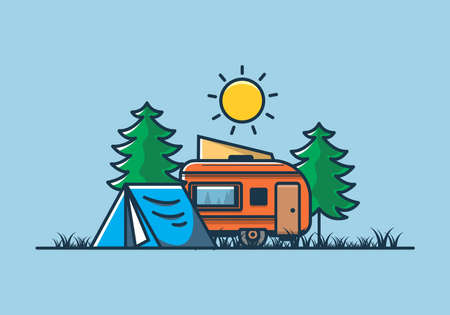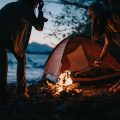1. Understand Your Trip and Prioritize
Packing light doesn’t mean sacrificing the things you truly need. It starts with understanding your trip and making smart choices based on that. Think about where youre going, what the weather will be like, and how long youll be gone. These details help you figure out what’s actually necessary—so you don’t bring five pairs of shoes when one sturdy pair will do.
Assess the Destination
Different locations have different needs. Heading to a national park? Youll want durable gear and layers. Staying at a campsite near a beach? You might focus more on sun protection and lighter clothing. Knowing your destination helps narrow down what’s useful versus what’s extra.
Check the Weather Forecast
Always look up the weather before packing. A week-long trip in summer heat requires fewer bulky items than a fall trip into the mountains. Pack items that serve multiple purposes—like a lightweight rain jacket that doubles as a windbreaker.
Match Your Gear to the Trip Duration
The length of your trip influences how much you really need. For shorter getaways, you can get by with fewer changes of clothes or smaller toiletries. Here’s a simple guide:
| Trip Length | Clothing Tips | Gear Suggestions |
|---|---|---|
| 1-2 Days | 1 outfit + 1 backup | Essentials only: sleeping bag, water bottle, snacks |
| 3-4 Days | 2-3 outfits, layerable items | Add cooking gear, compact camp chair |
| 5+ Days | Rotate outfits, prioritize quick-dry fabrics | Full setup: cookware, headlamp, small first aid kit |
Function Over Fashion
This is key when youre trying to pack light. Choose clothes that work hard—think moisture-wicking shirts, convertible pants, and jackets with pockets. It’s tempting to pack “just in case” outfits, but focusing on function means every item earns its place in your bag.
Pro Tip:
Stick to a neutral color palette so everything mixes and matches easily. That way, you can create multiple looks with just a few pieces.
2. Choose Multi-Use and Layer-Friendly Clothing
Packing light doesnt mean sacrificing comfort or style. The key is to bring clothes that serve more than one purpose and work well in different weather conditions. This way, you save space without leaving behind the essentials.
Go for Layering Basics
Instead of packing bulky items, choose lightweight pieces you can layer. Think moisture-wicking base layers, a mid-weight fleece, and a compact windbreaker or rain jacket. These layers allow you to adapt to changing temperatures throughout the day.
Stick to Neutral Colors
Neutral tones like black, gray, navy, and tan are easy to mix and match. You can create multiple outfits with fewer pieces if your clothing works well together. This makes it easier to dress appropriately whether youre hiking a trail or heading into town.
Choose Fabrics That Work Hard
Lightweight, quick-drying fabrics are your best friend when packing light. They not only help you stay comfortable in various climates but also dry fast after washing—perfect for longer trips where you might need to do laundry on the go.
Smart Clothing Choices for Light Packing
| Item | Why It Works |
|---|---|
| Moisture-Wicking T-Shirt | Keeps you dry and can double as sleepwear or a casual top |
| Convertible Pants | Zip-off legs give you both shorts and full-length pants in one |
| Lightweight Fleece Jacket | Warm without the bulk; easy to layer under a shell |
| Rain Shell | Packs small but protects against wind and rain |
| Buff or Neck Gaiter | Can be used as a scarf, headband, sun protection, or towel |
| Neutral-Colored Leggings or Joggers | Comfortable enough for sleeping, hiking, or lounging |
Pro Tip:
Try the “rule of three”: Pack three tops and three bottoms that all work together. That gives you nine outfit combinations without overpacking.

3. Use the Right Bag with Smart Compartments
When youre trying to pack light without leaving behind the essentials, choosing the right bag can make all the difference. Whether you’re heading out for a weekend camping trip or flying across the country for a hiking adventure, your bag should work with you—not against you.
Select a Bag Built for the Outdoors
Go for a high-quality backpack or duffel that’s made specifically for outdoor use. These bags are usually built tougher, weather-resistant, and come with features that help you stay organized on the go. Look for reinforced stitching, water-resistant zippers, and durable materials like ripstop nylon or polyester.
Prioritize Smart Compartments
The best travel bags offer smart compartments that let you separate your gear by category—think clothes, toiletries, electronics, and food. This makes it easier to find what you need without unpacking everything each time. Here’s a quick look at what kind of compartments to look for:
| Compartment Type | Best For |
|---|---|
| Main Compartment | Clothes and bulkier items |
| Top Pocket | Sunglasses, snacks, small essentials |
| Side Pockets | Water bottles or quick-grab items |
| Internal Zippered Pouches | Valuables like keys, wallet, passport |
| Laptop Sleeve (if needed) | Tablet or laptop if traveling digitally connected |
If Youre Flying—Think TSA-Friendly and Carry-On Size
If your camping trip involves air travel, pick a bag that meets carry-on size limits so you don’t have to check luggage. Many outdoor backpacks are designed to be TSA-friendly with clamshell openings and padded laptop sleeves that make security checks quicker and easier.
Pro Tip:
Always double-check airline carry-on dimensions before you fly—some budget airlines have stricter size rules!
Comfort Counts Too
A lightweight pack is only helpful if it’s comfortable to carry. Look for padded shoulder straps, breathable back panels, and adjustable waist belts to distribute weight evenly. A good fit can prevent fatigue and back pain during long treks.
Key Takeaway:
Packing light starts with choosing the right bag. Go for one that suits your trip style, keeps your gear organized, and is friendly for both trails and terminals.
4. Minimize Toiletries and Opt for Travel Sizes
When youre packing light, your toiletry bag is a great place to save space and cut weight. Stick to the essentials—things you’ll actually use every day while camping. This usually means leaving behind bulky bottles and choosing compact, efficient alternatives.
Essential Toiletries to Bring
Not sure what to pack? Heres a quick guide to help you choose the basics:
| Item | Why Its Essential | Lightweight Tip |
|---|---|---|
| Biodegradable Soap | Good for body, dishes, and the environment | Choose a multi-use formula in a small bottle |
| Sunscreen (SPF 30+) | Protects skin from UV rays during outdoor activities | Go for stick or travel-sized tubes |
| Toothbrush Kit | Keeps up basic hygiene on the go | Use foldable or mini brushes with travel-size toothpaste |
Try Solid Alternatives
Solid toiletries are game-changers for minimalist packing. They take up less space, won’t leak in your bag, and often last longer than their liquid counterparts. Consider switching to these solid options:
- Shampoo bars instead of bottled shampoo
- Solid deodorant instead of spray or gel types
- Bar soap instead of body wash
Pack Smart with TSA-Approved Sizes
If you’re flying before heading to your campsite, make sure all liquids follow TSA’s 3.4 oz (100ml) rule and fit in a quart-sized zip-top bag. Even if youre not flying, these sizes help keep your load light and organized.
Pro Tip:
Refillable silicone travel bottles are perfect for packing just enough of your favorite products without bringing the whole bottle.
5. Use Packing Cubes and Roll Your Clothes
Packing light doesn’t mean sacrificing organization. One of the easiest ways to keep your gear neat and compact is by using packing cubes or zip pouches. These handy tools help you group similar items together—like shirts, socks, or toiletries—so youre not rummaging through your bag every time you need something.
Why Packing Cubes Work
Packing cubes are a game changer for travelers and campers alike. They let you:
- Maximize space by compressing soft items
- Stay organized with clearly separated categories
- Save time when unpacking at your campsite
Example: How You Might Pack Using Cubes
| Cubed Category | Contents |
|---|---|
| Clothing Cube | T-shirts, pants, underwear, socks (all rolled) |
| Toiletry Pouch | Toothbrush, toothpaste, soap, travel-sized shampoo |
| Gear Bag | Flashlight, batteries, pocket knife, first aid kit |
The Rolling Method: Save Space & Prevent Wrinkles
If youre still folding clothes the traditional way, it’s time for an upgrade. Rolling your clothes instead of folding them helps prevent wrinkles and lets you fit more into each cube or pouch. It also makes it easier to see what you’ve packed at a glance.
Quick Tip:
Roll softer items like t-shirts and leggings tightly; bulkier items like jackets can be folded once and placed flat against the bottom of your pack to create a solid base.
This simple combo—packing cubes and rolling clothes—lets you bring everything you need without overstuffing your backpack or duffel. Its a small change that makes a big difference on the trail or at the campground.
6. Leave Room for Must-Have Gear and Snacks
When youre packing light for a camping trip, its easy to focus on minimizing weight and forget about the small items that can make a big difference. But skipping essential gear or snacks can lead to uncomfortable—or even unsafe—situations. The key is to pack smart, not just light.
Prioritize Your Non-Negotiables
There are some items every camper should always have, no matter how light theyre trying to travel. These essentials don’t take up much room but are crucial for safety and convenience:
| Item | Why It’s Essential |
|---|---|
| Headlamp | Hands-free lighting for cooking, bathroom trips, or emergencies at night. |
| Multitool | Combines several tools in one compact device—perfect for gear fixes or food prep. |
| First-Aid Kit | Accidents happen. A basic kit helps you treat cuts, blisters, or insect bites quickly. |
| Compact Snacks | Lightweight energy boosters like trail mix or protein bars keep you fueled during hikes. |
Pack With Intention
The trick is not just tossing these items in last minute. Instead, plan your pack around them. Use small pouches or zip bags to organize gear so it’s easy to find when you need it. Tuck snacks into side pockets or top compartments where they’re accessible without unpacking everything.
Quick Tips:
- Use packing cubes or stuff sacks to separate categories of gear.
- Keep heavy items close to your back and centered for better balance.
- Don’t overpack “just in case” extras—stick with proven must-haves.
Remember:
Packing light doesn’t mean cutting corners on the things that matter most. A well-organized backpack that includes your must-have gear and go-to snacks ensures you’re ready for anything on the trail—without feeling weighed down.


